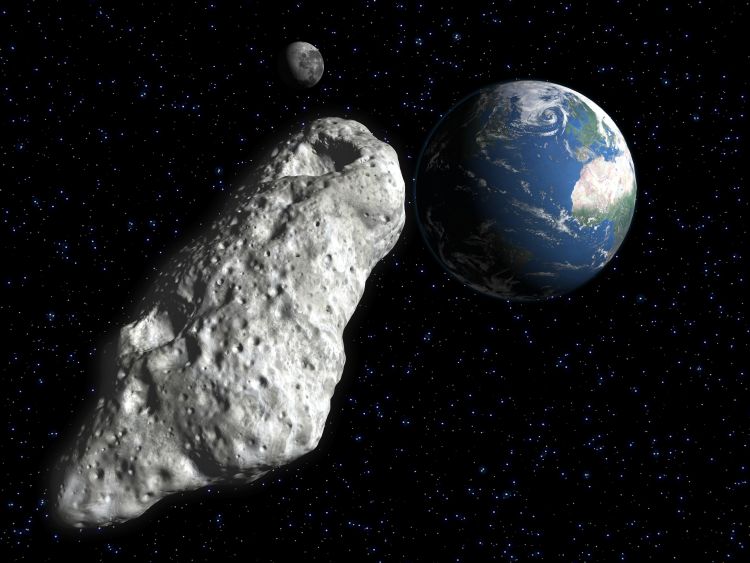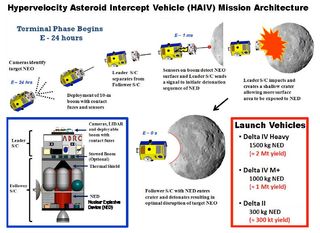Nuking Dangerous Asteroids Might Be the Best Protection, Expert Says

If a dangerous asteroid appears to be on a collision course for Earth, one option is to send a spacecraft to destroy it with a nuclear warhead. Such a mission, which would cost about $1 billion, could be developed from work NASA is already funding, a prominent asteroid defense expert says.
Bong Wie, director of the Asteroid Deflection Research Center at Iowa State University, described the system his team is developing to attendees at the International Space Development Conference in La Jolla, Calif., on May 23. The annual National Space Society gathering attracted hundreds from the space industry around the world.
An anti-asteroid spacecraft would deliver a nuclear warhead to destroy an incoming threat before it could reach Earth, Wie said. The two-section spacecraft would consist of a kinetic energy impactor that would separate before arrival and blast a crater in the asteroid. The other half of the spacecraft would carry the nuclear weapon, which would then explode inside the crater after the vehicle impacted. [Gallery: Potentially Dangerous Asteroids]
The goal would be to fragment the asteroid into many pieces, which would then disperse along separate trajectories. Wie believes that up to 99 percent or more of the asteroid pieces could end up missing the Earth, greatly limiting the impact on the planet. Of those that do reach our world, many would burn up in the atmosphere and pose no threat.
Wie's study has focused on providing the capability to respond to a threatening asteroid on short notices of a year or so. The plan would be to have two spacecraft on standby — one primary, the other backup — that could be launched on Delta 4 rockets. If the first spacecraft failed on launch or didn't fragment the asteroid, the second would be sent aloft to finish the job.
Political fallout
Wie admitted that sending nuclear weapons into space would be politically controversial. However, he said there are a number of safety features that could be built into the spacecraft to prevent the nuclear warhead from detonating in the event of a launch failure.
Get the Space.com Newsletter
Breaking space news, the latest updates on rocket launches, skywatching events and more!
A nuclear weapon is the only thing that would work against an asteroid on short notice, Wie added. Other systems designed to divert an asteroid such as tugboats, gravity tractors, solar sails and mass drivers would require 10 or 20 years of advance notice.
Much of the technology for the mission has already been successfully demonstrated in flight, Wie said. NASA's Deep Impact spacecraft sent a kinetic impactor to collide with Comet Tempel 1 on July 4, 2005. Four years later, the space agency sent a Centaur upper stage crashing into the moon during the LCROSS mission (Lunar Crater Observation and Sensing Satellite), followed by a sub-satellite that photographed the impact before crashing into the surface itself.

Funding the mission
Wie's work has been funded under the NASA Innovative Advanced Concepts (NIAC) program. He received a $100,000 Phase I grant for 2011-2012 and then a Phase II grant worth $500,000 for 2012-2014.
NIAC doesn't provide any additional funding after Phase II, so Wie will have to convince some agency — whether it be NASA or the Department of Defense — to fund the program through completion. This could be a difficult issue because there is no one agency in charge of planetary defense, he said.
The first step would be a $500 million flight validation mission that would target an asteroid approximately 50 meters in size. A nuclear weapon probably would not be required to destroy a body of that size, Wie said.
The point would be to demonstrate the capability to accurately target an asteroid that small, something that neither Deep Impact nor LCROSS accomplished. Accurately hitting a larger, more threatening asteroid would be easier.
Follow SPACE.com @Spacedotcom, Facebook and Google+. Original article on SPACE.com.
Join our Space Forums to keep talking space on the latest missions, night sky and more! And if you have a news tip, correction or comment, let us know at: community@space.com.
Douglas Messier is the managing editor of Parabolicarc.com, a daily online blog founded in 2007 that covers space tourism, space commercialization, human spaceflight and planetary exploration. Douglas earned a journalism degree from Rider University in New Jersey as well as a certificate in interdisciplinary space studies from the International Space University. He also earned a master's degree in science, technology and public policy from George Washington University in Washington, D.C. You can follow Douglas's latest project on Twitter and Parabolicarc.com.
